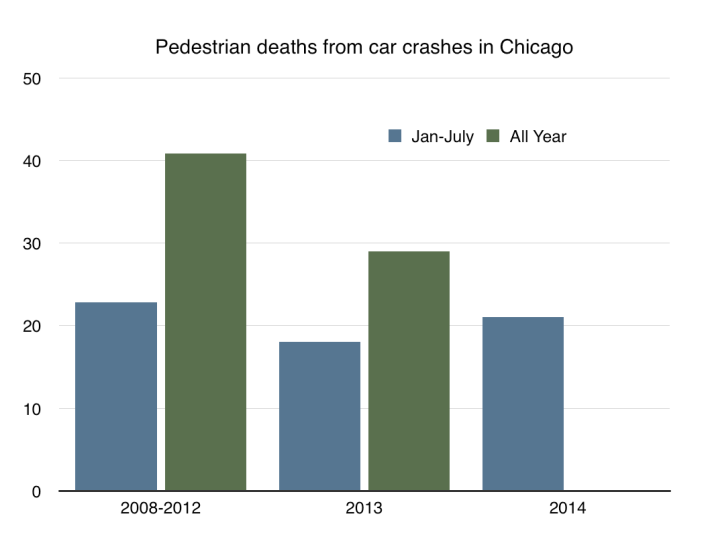
More people were killed while walking in Chicago in the first seven months of this year, compared to the same time period last year. Chicago transportation commissioner Rebekah Scheinfeld pointed out to the Mayor's Pedestrian Advisory Council last week that "this is the first increase since 2009."
21 people on foot died in car crashes between January and July of this year, versus 18 who died in the same months in 2013. Scheinfeld said that major injuries to pedestrians have also increased, by eight percent over last year's rate. She noted that the number of miles that people have driven in Chicago has also increased, and suggested that may be a factor in the increase this year.
The 21 deaths this year are still fewer than the 2008-2012 average, Scheinfeld said – and far below the unusually high number of deaths in 2012, when 47 pedestrians were killed in car crashes. Last year's 29 pedestrian deaths were one-third fewer than the five-year average, and 40 percent below 2012's death toll.
Statewide, traffic deaths of all kinds are down: 62 fewer people have died in Illinois so far this year, compared to the same time period in 2013. Chicago also seems to fare better than other major cities. According to Smart Growth America's Dangerous by Design report, there are more pedestrian deaths per capita in the New York City metro area than Chicago – but, since New Yorkers walk more often than Chicagoans, on average a pedestrian there is less likely to get hit by a car. In the Washington, D.C. metro, there are more pedestrian deaths per capita than in Chicago, and a greater likelihood of being hit by a car. The Boston area has a lower pedestrian death and injury rate than the other cities.
Scheinfeld presented the fatality figures as part of a discussion of real-world safety issues facing pedestrians, but the attention given to these life-and-death matters remains woefully inadequate. The meeting agenda allocated just three minutes to report and discuss fatalities. When the commissioner offered the council more time, saying "I’d be happy to go into details," the council did not take her up on that offer.
If CDOT is going to take Vision Zero seriously, and achieve its goal of having no traffic deaths by 2022, then the Pedestrian Advisory Council needs both more actionable information and more detailed discussion. CDOT should start by making more data available to both the council and the public – including both what's happening in peer cities, and better reporting on crashes which result in injuries but not deaths. The Pedestrian Plan calls for publishing a website featuring these data in 2015, similar to how the New York Police Department publishes monthly crash statistics with details including causes, injuries, vehicles, and people.
Scheinfeld also can report to the council what CDOT's post-crash field investigations determined after each fatality. CDOT has done these investigations after deadly crashes, which could include site-specific short and long-term recommendations that might prevent future casualties at these dangerous locations.



